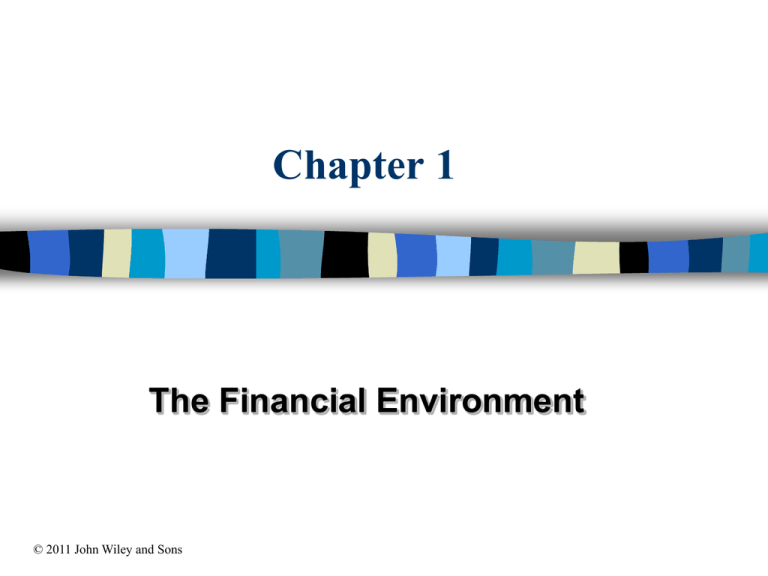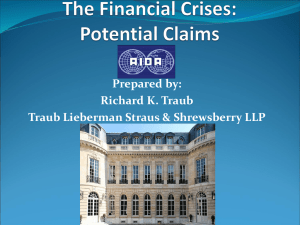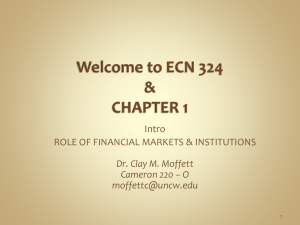Chapter 9
advertisement

Chapter 1 The Financial Environment © 2011 John Wiley and Sons Chapter Outcomes Define finance and explain why it should be studied Describe the six principles of finance Identify characteristics of an effective financial system Describe financial functions performed in an effective financial system 2 Chapter Outcomes (Continued) Describe the four types of financial markets Describe characteristics of the mortgage markets Discuss the developments that led to the recent financial crisis Identify several major career opportunities in finance 3 What is Finance? FINANCE: Study of how individuals, institutions, governments, and businesses acquire, spend, and manage money and other financial assets FINANCIAL ENVIRONMENT: Encompasses the financial system, institutions, markets, and individuals that make the economy operate efficiently 4 Three Areas of Finance within the Financial System Institutions and Markets Investments Financial Management [Note: These areas do not operate in isolation but rather interact or intersect with each other. Figure1.1 provides a graphic illustration. ] 5 Finance Area Definitions FINANCIAL INSTITUTIONS: Help the financial system operate efficiently and transfer funds from savers to investors FINANCIAL MARKETS: Physical locations or electronic forums that facilitate the flow of funds 6 Finance Area Definitions (Continued) INVESTMENTS: Area involves sale or marketing of securities, analysis of securities, and management of investment risk FINANCIAL MANAGEMENT: Involves financial planning, asset management, and fund raising decisions to enhance firm value 7 Two Themes within the Finance Topic ENTREPRENEURIAL FINANCE: Study of how growth-driven, performancefocused, early-stage firms raise funds and manage operations and assets PERSONAL FINANCE: Study of how individuals prepare for financial emergencies, protect against premature death and the loss of property, and accumulate wealth 8 Why Study Finance? 1. To make informed economic decisions 2. To make informed personal and business investment decisions 3. To make informed career decisions based on a basic understanding of business finance 9 Six Principles of Finance Money has a time value Higher returns are expected for taking on more risk Diversification of investments can reduce risk 10 Six Principles of Finance (Cont’d) Financial markets are efficient in pricing securities Manager and stockholder objectives may differ Reputation matters 11 1. Time Value of Money Money in hand today is worth more than the promise of receiving the same amount of money in the future Time value of money exists because a sum of money today could be invested and “grow” over time 12 2. Risk-Return Tradeoff Risk is the uncertainty about the outcome or payoff of an investment in the future Rational investors would choose a riskier investment only if they feel the expected return is high enough to justify the greater risk 13 3. Diversification of Investments All investment risk is not the same Some risk can be removed or diversified by investing in several different assets or securities We will explore the benefits of investment diversification in Part 2 of this text 14 4. Efficient Financial Markets A financial market is “information efficient” if at any point in time the prices of securities reflect all information available to the public When new information becomes available, prices quickly change to reflect that information Information efficient markets provide liquidity and fair prices 15 5. Management Vs. Owner Objectives Management objectives may differ from owner objectives (called principal-agent problem) Owners or equity investors want to maximize the returns on their investments Managers may seek to emphasize the size of firm sales, assets, or other perks Solution: tie manager compensation to performance measures beneficial to owners 16 6. Reputation Matters! Ethical Behavior: How an individual or organization treats others legally, fairly, and honestly High reputation value reflects high quality ethical behavior, so employing high ethical standards is the “right” thing to do 17 Overview of the Financial System Policy Makers President, Congress & U.S. Treasury Federal Reserve Board Role: Pass laws & set fiscal & monetary policies Monetary System Federal Reserve Central Bank Commercial Banking System Role: Create & transfer money 18 Overview of the Financial System Financial Institutions Depository Institutions, Contractual Savings organizations, Securities Firms, and Finance Firms Role: Accumulate & lend/invest savings Financial Markets Securities Markets, Mortgage Markets, Derivatives Markets, and Currency Exchange Markets Role: Market & facilitate transfer of financial assets 19 Financial System Components and Financial Functions MONETARY SYSTEM: Creating money Transferring money FINANCIAL INSTITUTIONS: Accumulating savings Lending/investing savings FINANCIAL MARKETS: Marketing financial assets Transferring financial assets 20 Financial Markets Characteristics Money Markets: where debt securities with maturities of one year or less are issued/traded Capital Markets: where debt securities with maturities longer than one year and corporate equity securities are issued/traded 21 Financial Markets Characteristic Primary Markets: where the initial offering/origination of debt and equity securities takes place Secondary Markets: where the transfer of existing bonds, mortgages, and equity securities between investors occurs 22 Major Types of Financial Markets Debt Securities Markets: where money market securities, bonds, & mortgages are sold and traded Equity Securities Markets: where ownership rights in the form of stocks are initially sold and traded 23 Major Types of Financial Markets Derivative Securities Markets: where financial contracts that derive their values from underlying securities are originated and traded Foreign Exchange Markets: electronic markets in which banks & traders buy and sell currencies on behalf of businesses and clients 24 Mortgage Markets Mortgage: loan backed by real property in the form of buildings and houses Mortgage Markets: where mortgage loans to purchase buildings and houses are originated and traded 25 Mortgage Markets Fixed-Rate Mortgage: fixed interest rate with a constant periodic payment over the real estate loan’s life Adjustable-Rate Mortgage (ARM): interest rate and periodic payments that vary with market interest rates over the real estate loan’s life 26 Mortgage Markets Securitization: process of pooling or packaging mortgage loans into debt securities Mortgage-Backed Security: debt security created by pooling together a group of mortgage loans 27 Mortgage Markets Credit Rating: indicates the expected likelihood that a borrower will pay a debt according to the terms agreed to Credit Score: number that indicates likelihood that a borrower will make loan payments when due 28 Mortgage Markets Prime Mortgage: home loan made to borrower with a relatively high credit score (loan payments are likely as agreed to) Subprime Mortgage: home loan made to borrower with a relatively low credit score (loan payments might be missed when due) 29 The 2007-09 Financial Crisis Perfect Financial Storm: several negative economic and financial trends/events all came together to contribute to the crisis Housing Markets: housing prices peaked in 2006 and then began a sharp, long decline 30 The 2007-09 Financial Crisis Stock Market Prices: peaked in mid-2007 and declined sharply until reaching a bottom in March, 2009 Economic Activity: economy entered a steep recession in mid-2008 and continued until mid2009 31 The 2007-09 Financial Crisis High Debt Levels: individuals, financial institutions, and business firms were heavily in debt Resulting Developments: weaker financial institutions merged, failed, or were “bailed-out” by the U.S. government 32 The 2007-09 Financial Crisis Economic Stabilization Act of 2008: provided the U.S. Treasury to purchase up to $700 billion of troubled assets from institutions American Recovery & Reinvestment Act of 2009: provided $787 billion for tax relief, appropriations, and direct spending 33 Careers in Finance Financial management Depository financial institutions Contractual savings and real property organizations Securities markets and investment firms 34 Entry-Level Finance Positions Financial Management Cash management analyst Capital expenditures analyst Credit analyst Financial analyst Cost analyst Tax analyst 35 Entry-Level Finance Positions Depository Financial Institutions Loan analyst Bank teller Investments research analyst 36 Entry-Level Finance Positions Contractual Savings and Real Property Organizations Insurance agent (broker) Research analyst Real estate agent (broker) Mortgage analyst 37 Entry-Level Finance Positions Securities Markets and Investment Firms Stock broker (account executive) Security analyst Investment banking analyst Financial planner assistant 38 Plan Of Study PART 1: INSTITUTIONS AND MARKETS focuses on the role financial markets play in the financial system and financial basics that underlie how markets operate PART 2: INVESTMENTS focuses on the characteristics of stocks and bonds, how securities are valued, and the operations of securities markets 39 Plan of Study (Continued) PART 3: FINANCIAL MANAGEMENT focuses on the financial planning, asset management, and fund raising activities that will enhance firm value 40 Web Links www.sba.gov www.sba.gov/advo www.federalreserve.gov www.businessweek.com www.treas.gov www.careerjournal.com www.monster.com 41







